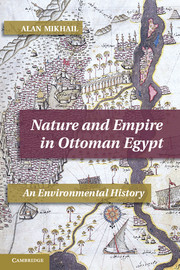Book contents
- Frontmatter
- Contents
- Maps
- Figures
- Tables
- Note on Transliteration and Dates
- Abbreviations
- Acknowledgments
- Map 1 Egypt and the Ottoman Empire
- Map 2 Lower Egypt (Nile Delta)
- Map 3 Middle Egypt
- Map 4 Upper Egypt
- Map 5 Cairo and Surroundings, 1801
- Introduction: Empire by Nature
- 1 Watering the Earth
- 2 The Food Chain
- 3 The Framework of Empire
- 4 In Working Order
- 5 From Nature to Disease
- 6 Another Nile
- Conclusion: The Imagination and Reality of Public Works
- Appendix: Citations for Cases Included in Tables 2.1–2.4
- Bibliography
- Index
- Titles in the series
1 - Watering the Earth
Published online by Cambridge University Press: 03 May 2011
- Frontmatter
- Contents
- Maps
- Figures
- Tables
- Note on Transliteration and Dates
- Abbreviations
- Acknowledgments
- Map 1 Egypt and the Ottoman Empire
- Map 2 Lower Egypt (Nile Delta)
- Map 3 Middle Egypt
- Map 4 Upper Egypt
- Map 5 Cairo and Surroundings, 1801
- Introduction: Empire by Nature
- 1 Watering the Earth
- 2 The Food Chain
- 3 The Framework of Empire
- 4 In Working Order
- 5 From Nature to Disease
- 6 Another Nile
- Conclusion: The Imagination and Reality of Public Works
- Appendix: Citations for Cases Included in Tables 2.1–2.4
- Bibliography
- Index
- Titles in the series
Summary
No land ever depended on water management more than Egypt. Its irrigation system is among the world's oldest. When the Ottomans conquered Egypt in 1517, they inherited a complex system, the result of millennia of careful trial and error, accumulated knowledge, and hard labor. Their prior experience in Anatolia and the Balkans, although it included irrigation, did not suffice to allow them to grasp the Egyptian situation fully. They thus needed expert help with the management of water in Egypt, and they got it from Egyptian peasants.
In the Ottoman imperial system of natural resource balance and extraction, irrigation in Egypt created sets of connections, tensions, and relationships that tied the province to the rest of the Empire. Egypt could function as the most agriculturally and financially productive area of the Empire only if its fields had adequate supplies of water. Thus, throughout the long eighteenth century, Egyptian peasants came to the network of Islamic courts maintained throughout Egypt by the Ottoman administration of the province to stake claims to water usage in the countryside. Using only a necessarily tiny fraction of the vast wealth of archival materials related to irrigation in eighteenth-century rural Egypt, this chapter charts the history of Egyptian peasants' and Ottoman bureaucrats' efforts to organize water usage and the repair and maintenance of irrigation works.
I make three main arguments in this chapter. The first is that water usage created community.
- Type
- Chapter
- Information
- Nature and Empire in Ottoman EgyptAn Environmental History, pp. 38 - 81Publisher: Cambridge University PressPrint publication year: 2011
- 1
- Cited by

